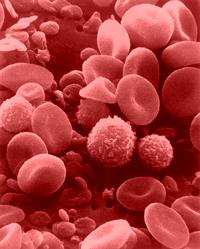Haemophiliacs and their treatment – danger signals involved in immune response against factor-VIII

Photographic image taken under an electron microscope: Red blood cells, leukocytes and platelets National Cancer Institute
Haemophilia A is the most common congenital blood coagulation disorder. It is caused by various mutations in the so-called factor VIII (F8) gene. Depending on the type of mutation, the coagulation factor VIII is not formed in sufficient quantities or is missing entirely.
The missing coagulation factor is replaced by intravenous administration of so-called factor-VIII concentrates. However, around a quarter of treated patients who have severe haemophilia develop antibodies against factor VIII – the body treats the coagulations factor like a foreign body and inactivates it using its immune system.
One essential risk factor for the development of these inhibitors is a pronounced F8 mutation. However, not all patients who have such a mutation develop inhibitors, and, vice versa, inhibitors can also be found in a part of the patients with only minor alterations of the F8 gene. What complicates understanding the underlying mechanisms even more is that antibodies against factor VIII can be detected in some healthy individuals, too.
Inhibitors against factor-VIII concentrates partly make treatments of the patients concerned very difficult, and in extreme cases, they can lead to uncontrollable bleedings. For this reason, the team of scientists of Dr Zoe Waibler, head of Section Product Testing of Immunological Biomedicines of the Division Immunology at the Paul-Ehrlich-Institut has performed research on the underlying mechanisms in search of a possibility to prevent the formation of these inhibitors.
In previous research activities, she and her team had shown that certain “danger signals” in the blood such as particular surface molecules of bacteria (LPS, lipopolysaccharides) that warn the body of a pathogenic agent will increase the immunogenicity of factor-VIII products [1]. Immunogenicity describes the ability of molecules to elicit an immune reaction. Another example of this is cell stress resulting from surgical intervention, which transmits danger signals by releasing particular substances.
The increased immunogenicity of factor-VIII products causes so-called dendritic cells (DCs) to be activated to an increasing extent. These immune cells present antigens on their surface, i.e. molecular structures against which an immune response can be mediated. They form part of the innate immune system. In connection with other molecules, this leads to the formation of a subgroup of immune cells of the acquired immune system, the CD4-positive T cells, which are also called T helper cells.
Waibler’s team was now able to show that DCs, which are activated by the factor-VIII concentrate and the danger signal LPS synergistically, mediate a considerably stronger T helper cell activation than DCs, which were pre-treated solely with either factor VIII or LPS alone. In addition, they were able to clarify the dependency of T-cell activation on further immunological processing steps.
“Our results are another step on the road towards clarifying these complex immunological processes. This is a prerequisite for developing new approaches to haemophilia therapies which prevent the formation of these inhibitors against factor-VIII products”, said Waibler when explaining the significance of the results.
1. Miller L et al.: Danger signal-dependent activation of human dendritic cells by plasma-derived factor VIII products. Thromb Haemost. 2015 Aug;114(2):268-76
Original publication:
(DOI:)
Miller L, Ringler E, Kistner KM, Waibler Z; ABIRISK Consortium (2017): Human dendritic cells synergistically activated by FVIII plus LPS induce activation of autologous CD4+ T cells. Thromb Haemost. 2018 Mar 19. doi: 10.1055/s-0038-1637734
The Paul-Ehrlich-Institut, the Federal Institute for Vaccines and Biomedicines, in Langen near Frankfurt/Main is a senior federal authority reporting to the Federal Ministry of Health (Bundesministerium für Gesundheit, BMG). It is responsible for the research, assessment, and marketing authorisation of biomedicines for human use and immunological veterinary medicinal products. Its remit also includes the authorisation of clinical trials and pharmacovigilance, i.e. recording and evaluation of potential adverse effects. Other duties of the institute include official batch control, scientific advice and inspections. In-house experimental research in the field of biomedicines and life science form an indispensable basis for the manifold tasks performed at the institute. The Paul-Ehrlich-Institut, with its roughly 800 members of staff, also has advisory functions nationally (federal government, federal states (Länder)), and internationally (World Health Organisation, European Medicines Agency, European Commission, Council of Europe etc.).
https://www.ncbi.nlm.nih.gov/pubmed/?term=Human+dendritic+cells+synergistically+… – Abstract
https://www.pei.de/EN/information/journalists-press/press-releases/2018/05-haemo… press release
Media Contact
All latest news from the category: Life Sciences and Chemistry
Articles and reports from the Life Sciences and chemistry area deal with applied and basic research into modern biology, chemistry and human medicine.
Valuable information can be found on a range of life sciences fields including bacteriology, biochemistry, bionics, bioinformatics, biophysics, biotechnology, genetics, geobotany, human biology, marine biology, microbiology, molecular biology, cellular biology, zoology, bioinorganic chemistry, microchemistry and environmental chemistry.
Newest articles
Faster, more energy-efficient way to manufacture an industrially important chemical
Zirconium combined with silicon nitride enhances the conversion of propane — present in natural gas — needed to create in-demand plastic, polypropylene. Polypropylene is a common type of plastic found…

Energy planning in Ghana as a role model for the world
Improving the resilience of energy systems in the Global South. What criteria should we use to better plan for resilient energy systems? How do socio-economic, technical and climate change related…

Artificial blood vessels could improve heart bypass outcomes
Artificial blood vessels could improve heart bypass outcomes. 3D-printed blood vessels, which closely mimic the properties of human veins, could transform the treatment of cardiovascular diseases. Strong, flexible, gel-like tubes…




















